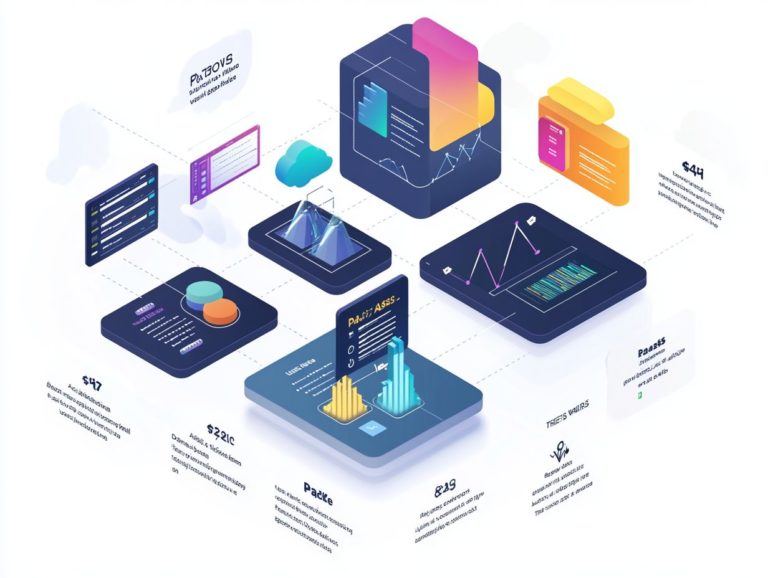5 Essential Features of a PaaS Solution
Contents
Understanding PaaS: Key Features and Benefits
In today s fast-paced digital landscape, act now to stay competitive! Businesses are increasingly leaning toward Platform as a Service (PaaS) solutions to streamline their application development and deployment processes.
This article delves into five essential features that make PaaS an enticing choice for you: scalability, flexibility, multiple cloud platforms, DevOps integration, and cost-effectiveness.
It also highlights the significance of PaaS, the various types available, and the numerous benefits it offers. You ll also encounter key considerations and potential challenges worth noting.
Explore how PaaS can transform your business operations today!
Key Takeaways:

A PaaS solution must have scalability to meet changing business needs and handle increased traffic without compromising performance.
Flexibility is crucial in a PaaS solution as it allows for customization and integration with existing tools and technologies, ultimately showcasing 5 ways PaaS can reduce development time.
A good PaaS solution should support multiple cloud platforms, providing businesses with more options and greater flexibility in cloud management. Consider exploring 5 reasons to consider PaaS for your business to understand its benefits further.
1. Scalability
Scalability is a cornerstone of Platform as a Service (PaaS). It provides you with an essential framework that effortlessly accommodates increased workloads.
By leveraging cloud computing solutions like AWS Elastic Beanstalk and Microsoft Azure, you can easily scale applications to meet rising demands.
This flexibility in scalable hosting enables your business to enhance application performance without sacrificing cost efficiency or user experience.
Ensuring that your managed infrastructure dynamically adapts to varying traffic levels while maintaining built-in security and reliability is crucial.
In today’s fast-paced digital landscape, adaptability is key. You might face sudden spikes in user activity or experience steady growth over time.
Take Google App Engine, for example; it supports vertical scaling, allowing you to upgrade the resources of existing servers. It also enables horizontal scaling by deploying multiple instances of your applications across various regions.
Integrating real-time communications, such as WebSocket support, means your applications can handle simultaneous connections without latency issues.
Cloud assessment tools are invaluable, offering insights into resource utilization and performance metrics. With this information, you can make data-driven decisions that optimize scalability and maximize operational efficiency.
2. Flexibility
Flexibility stands out as one of the key advantages of Platform as a Service (PaaS). It allows you to design cloud-based applications using various programming languages and frameworks that suit your specific needs, as highlighted in 5 ways to enhance collaboration using PaaS.
This adaptability not only caters to a wide spectrum of coding preferences but also encourages innovation across your projects.
PaaS environments often integrate seamlessly with tools like Docker Swarm and Kubernetes, enhancing your application design and deployment processes.
These tools facilitate efficient container orchestration, enabling you to streamline development workflows, scale applications effortlessly, and maintain consistent performance.
By leveraging these powerful solutions, you can concentrate on building robust applications without the burden of infrastructure management.
This leads to quicker release cycles and improved collaboration across your cross-functional teams.
3. Multi-Cloud Support
Multi-cloud support is a crucial aspect of contemporary cloud computing. It enables you to harness the advantages of both public and private clouds for optimal performance and unparalleled flexibility.
By integrating various cloud platforms, such as Google App Engine and IBM Cloud, you can construct a resilient infrastructure that boosts operational efficiency.
This hybrid strategy tackles essential elements like disaster recovery and data backup.
Robust cloud management becomes essential, allowing for seamless monitoring and resource allocation across diverse environments.
This enables you to respond rapidly to fluctuating demands while ensuring your data remains secure and accessible.
4. DevOps Integration

Integrating DevOps within Platform as a Service (PaaS) boosts your application development lifecycle. It enables continuous integration and delivery through automated processes.
This smart approach accelerates development efforts and fosters collaboration among teams. Its built-in tools facilitate seamless real-time communication.
Performance monitoring tools help you quickly identify issues and optimize app performance, ensuring users enjoy a reliable experience.
Adopting best practices for application lifecycle management streamlines processes, effectively reducing bottlenecks and enhancing efficiency.
Together, these elements create a responsive environment, enabling you to adapt quickly to changing requirements while maintaining high-quality standards.
5. Cost-Effectiveness
Cost-effectiveness is crucial when considering Platform as a Service (PaaS). It can save you a lot of money by providing managed infrastructure and optimized resource allocation.
By reducing the need for hefty hardware investments and lightening the burden of maintaining physical servers, PaaS allows you to focus your financial resources on innovation and strategic initiatives.
Cloud assessments are key to this transition. They evaluate your current infrastructure and pinpoint areas ripe for cost reduction and process improvement.
These assessments not only provide insights into your usage patterns but also enable you to customize your cloud strategy. This maximizes efficiency and ensures you stay agile and competitive in a rapidly evolving market.
What Is PaaS and Why Is It Important?
Platform as a Service (PaaS) is a cloud service for developing applications. It offers you a managed environment, allowing you to focus on writing code while the cloud infrastructure handles underlying complexities.
Embracing this model can significantly enhance your efficiency and reduce the time-to-market for your innovative solutions. PaaS streamlines application lifecycle management, enabling teams to collaborate more effectively and experiment with new ideas.
Not only does PaaS lift the burden of infrastructure management, but it also ensures that your applications benefit from robust security measures and regular updates. For successful adoption, consider these 7 tips for a successful PaaS implementation. Its capacity for scalability and seamless integration with various services makes PaaS a crucial element in today’s fast-paced software development landscape, fostering a culture of continuous innovation.
What Are the Different Types of PaaS Solutions?
You will find a variety of Platform as a Service (PaaS) solutions on the market, including database as a service, middleware (which acts as a bridge between applications and databases), and dedicated integration platforms that address diverse application needs.
One standout option is Heroku, which streamlines the deployment process for developers. This allows teams to concentrate on coding instead of getting bogged down by infrastructure management.
On the other hand, Red Hat OpenShift offers a robust environment beneficial for enterprise-level applications, with a strong focus on containerization and scalability.
If you’re looking for powerful database management alongside your application development, Oracle Cloud is tailored for businesses like yours, providing a comprehensive suite of tools for analytics and performance optimization.
Each of these platforms tackles unique challenges and requirements, supporting various stages of the software development lifecycle while enhancing both agility and collaboration within your teams.
How Can a PaaS Solution Benefit Businesses?

A PaaS solution enhances your business. It boosts application development efficiency and fosters collaboration among your teams.
These platforms streamline workflows. This allows your developers to focus on coding without the burden of infrastructure management.
This shift accelerates the development process remarkably.
With integrated tools that promote seamless teamwork, your teams can share insights and updates instantaneously. The result? Quicker iterations and improved application performance, as issues are swiftly addressed.
The ability to leverage cloud resources enables you to scale applications efficiently, ensuring a smoother experience for your users.
What Are the Key Considerations When Choosing a PaaS Solution?
When selecting a PaaS solution, carefully weigh essential factors. These include cloud optimization, available development tools, security features, and user management capabilities.
These elements are pivotal in determining how effectively your applications will perform under various loads. This ensures that scalability transforms from a mere concept to a practical reality.
Proper cloud optimization significantly reduces latency. This enhances user experiences and maintains high engagement levels.
Robust development tools streamline your coding and deployment processes. They enable swift iterations and more efficient workflows.
On the security front, employing advanced encryption methods protects sensitive data. This ensures compliance with regulatory requirements while fostering trust with your end-users.
Ultimately, these considerations drive application performance and data integrity. They also contribute to the overall success of your cloud-based deployments, aligning your technology initiatives seamlessly with your business objectives.
How Can a PaaS Solution Help with Application Development and Deployment?
A PaaS solution elevates your application development and deployment. It offers automated deployment capabilities, robust testing tools, and understanding PaaS: key features and benefits for seamless support for continuous integration.
These automated tools refine your workflow. This allows you to focus on coding rather than getting bogged down in configuration.
Integrated testing tools ensure your applications function as intended. They enable you to pinpoint and resolve issues early in the development cycle. This approach enhances application performance and reduces downtime during deployment.
With such a comprehensive suite of features, the PaaS environment creates an ideal collaborative platform. Here, you can efficiently and iteratively improve your applications, leveraging PaaS features to look for, speeding up the time it takes to introduce new features and updates to the market.
What Are the Potential Challenges of Implementing a PaaS Solution?
Implementing a PaaS solution presents several challenges. These include complexities of cloud migrations, ensuring robust security features, and effectively managing databases, as well as understanding the essential features of a SaaS application.
Adapting existing workflows to integrate seamlessly with new platforms can lead to potential inefficiencies.
The rapid pace of technological advancements might leave you feeling overwhelmed. Concerns about future scalability and maintenance may loom large.
To successfully navigate these hurdles, conduct a comprehensive cloud assessment. Evaluate your current infrastructure, understand your specific needs, and align them with available PaaS offerings.
Identifying risks early makes a big difference. Choosing the right PaaS solution ensures a smoother transition and sets you up for long-term success.
Frequently Asked Questions

What are the 5 essential features of a PaaS solution?
The 5 innovative features in PaaS tools are scalability, flexibility, accessibility, security, and automation.
Consider evaluating PaaS solutions today for a competitive edge.
What does scalability mean in a PaaS solution?
Scalability in a PaaS solution means it can handle more workload without slowing down. The platform grows with your needs, ensuring smooth performance.
How does flexibility play a role in a PaaS solution?
Flexibility allows developers to use various programming languages and tools. This variety makes it easier to create and launch applications.
Why is accessibility important in a PaaS solution?
Accessibility means you can access the platform from anywhere with internet. This feature boosts productivity for remote teams working together.
How does a PaaS solution ensure security?
Security is vital. A PaaS solution uses data encryption, regular backups, and access controls to keep sensitive information safe.
What role does automation play in a PaaS solution?
Automation simplifies tasks like resource provisioning and application deployment. This saves developers time, letting them focus on building great applications.






